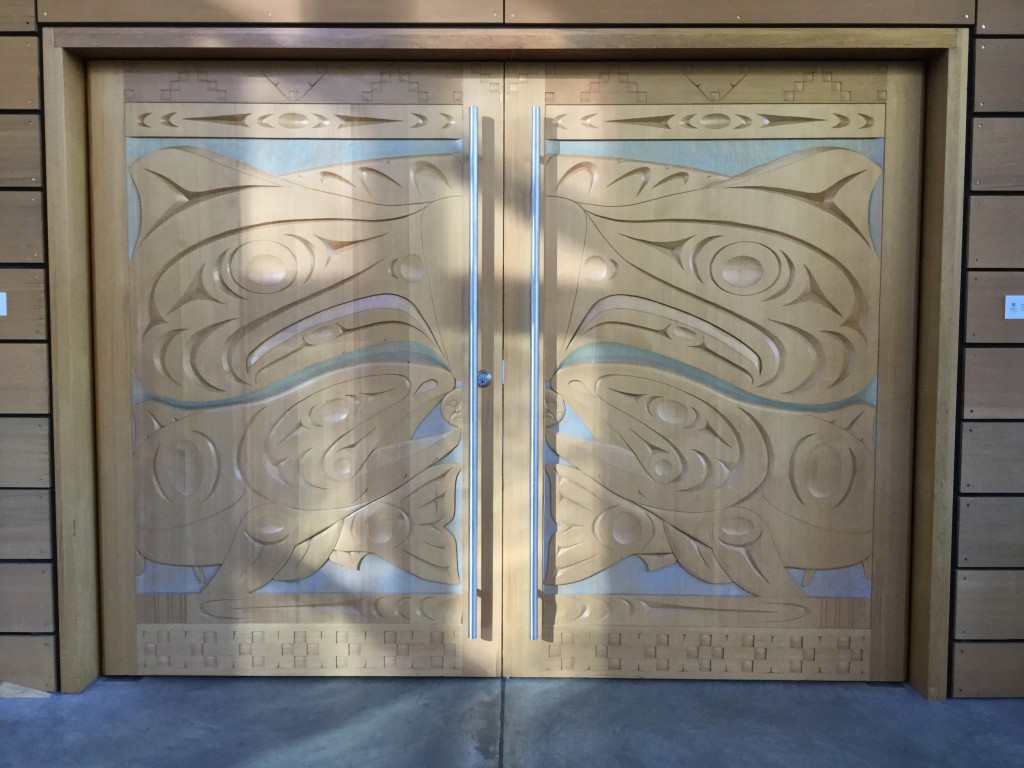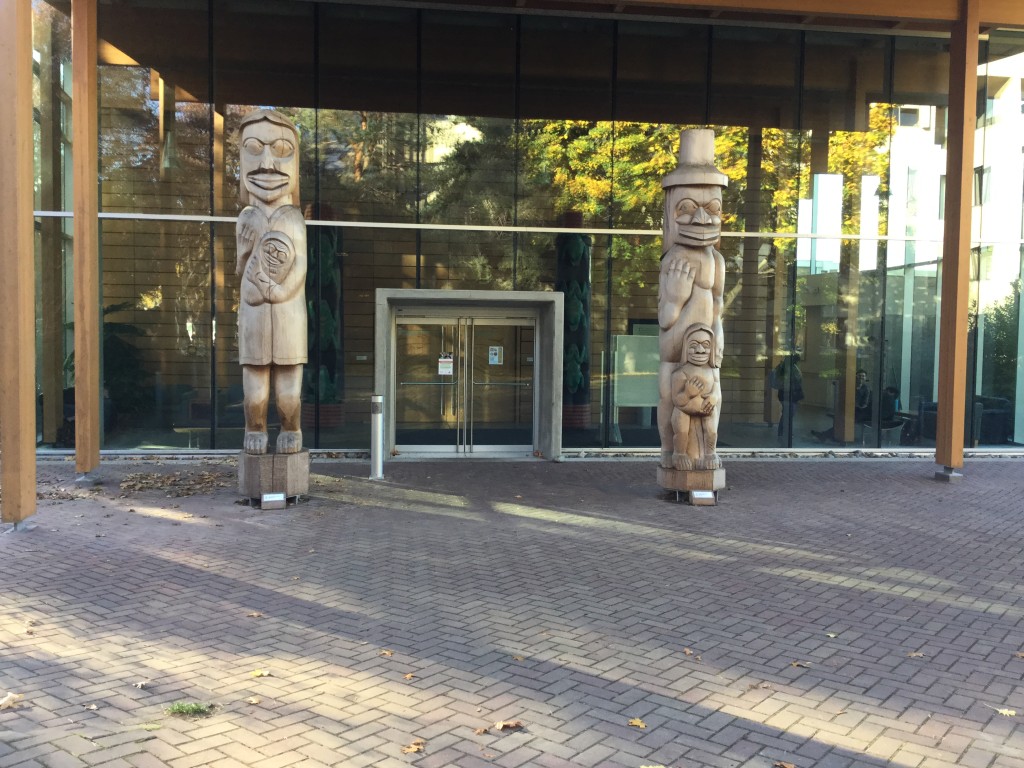A few weeks ago I had the opportunity to attend a gathering of “Forest School” enthusiasts in Victoria B.C. WOW! Coming from Manitoba, where we have only one Forest School program (at Discovery) and traveling to B.C. where dozens of these programs exist, can be somewhat overwhelming. If you are interested here are a few high-lights of what I heard while attending the event:
This is the building we met in, called “First Peoples Place”. It was an inspiring build to say the least.
 The grand entry way to the meeting room in which we met.
The grand entry way to the meeting room in which we met.
DAY ONE (a day with 4 researchers) at University of Victoria
It’s important to know what values you hold and to communicate these in various ways. “if you look after nature, she will look after you” seems to be a great place to start.
[list type=unordered extra=]
[list_item]Keynote Speaker David Sobel (Antioch U New England) shared that we need to think about nature as a child’s homeland. When we take children out of their homeland it usually results in poor outcomes.[/list_item]
[list_item]David also referred to the “indoorification” and the “acedemicfication” of schools in the USA which is not producing the results that they are looking for and shared his concern over this trend.[/list_item]
[list_item]David was quick to share that in his mind, British Columbia is a hot bed of Forest Schools for the whole North American continent.[/list_item]
[list_item]Michael Marker a researcher from UBC shared about his research and his thoughts on what he termed as “ecological violence”. In this context he shared that their were many similarities between the Residential Schools expereinces in our history and what we are doing to children by removing them from nature and expecting them to grow up without its influence in their lives! Thought provoking to say the least.[/list_item]
[list_item]Sean Blenkinsop (Simon Fraser University) shared about the two schools he oversees. One is a K-7 school with 88 students and no buildings! Now this was definitely the most extreme case of a Forest Schools, it kind of sends ones mind spinning in lots of directions. They rotate between a town site, a site by the creek, a forest site, and a meadow /grassland site depending on what the curriculum is expecting them to learn.[/list_item]
[/list]
A summary of the conclusions of the 4 researchers goes something like this, they agreed that their research is still raising more questions than it is answering, but of one thing they are very sure, there seems to be no loss of academic or other measures of success even when students are spending a whole day outside each week. This speaks to the fear that many teachers hold which is that their students will suffer academically if their classroom times is cut back.
DAY TWO at Royal Roads University
David Sobel (author/educator and key note speaker):
We have all hear it before but as a reminder from David Sobel here are the stats:
[list type=unordered extra=]
[list_item]80% of children in USA live in cities[/list_item]
[list_item]American children spend 8 hours in front of a screen each day[/list_item]
[list_item]Their outdoor time is between 30-60 minutes per day.[/list_item]
[/list]
David’s comments on the fear of abduction and our efforts to keep our children close to us and safe from harm:
[list type=unordered extra=]
[list_item]There has been a 90% reduction in the range of independent play of children in the last 100 years[/list_item]
[list_item]It is 1600 times more likely that a child will be injured in a car accident than that they will be abducted by a stranger. His belief is that our fear is misplaced and that we obviously accept the danger of vehicular travel with children due to the benefits but don’t use the same logic when assessing the benefits of nature verses the very small risks that it presents.[/list_item]
[list_item]Is convinced that all forest schools will need to develop a comprehensive “stick” policy! I tend to agree.[/list_item]
[list_item]Parental and community engagement is a critical part of forest school programs.[/list_item]
[/list]
Debra Harwood (Brook University):
Debra shared the a bit about the Danish model of Sustained Shared Thinking. It starts with common experiences moves to Interpretation and then to reflection.
Shared with the group some examples of provocations that can happen outdoors:
[list type=unordered extra=]
[list_item]measuring tree diameters with measuring tapes (sewing type).[/list_item]
[list_item]bringing out paint chips from a paint store and asking children to find something in nature that matches this colour.[/list_item]
[list_item]bringing clay into the forest for moulding and shaping.[/list_item]
[list_item]making a sign with the children and putting it up in the woods “Leave nothing but footprints, take nothing but pictures”.[/list_item]
[/list]
Bonnie (Victoria Nature Society)
Victoria Nature Societies program which does teacher training and also runs 10 week (one day per week) programs for KG and Grade one students on Mount Douglas in Victoria shared about their programs.
Clayton (Maple Ridge & Pit Meadows)
Maple Ridge & Pit Meadows program are two schools which uses a multi age approach working with K-Grade 7 children. Maple Ridge is a school without buildings and Pit Meadows has two portable classrooms attached to a conventional school which they use from time to time. These folks set up their site each day and take it down each day. They use Pop-Up tents as their place of shelter. They do not have a building at all, and do use conventional teaching practises until they can find a way to teach it through nature. These folk are consistently checking in with nature to see what she is saying about using the space.
Cindy Romanowski (Abbotsford School District)
They started Nature Kindergarten programs in two of their schools this year. This was driven by pressure from families to see these types of programs in their community. They have 80 students in these programs. She also talked a fair bit about the “Risk Assessment” document that they developed. Registration involved a Parent Information Night which led to a huge uptake from parents so they decided against using a first come first serve method of accepting children and used more of a “lottery” model. A discussion ensued at this time regarding “Children with Disabilities” and I believe it was Clayton who shared that they look for a family with a good fit, a child who responds to the word “stop” and who does not hurt themselves or others as criteria for accepting children.
These are comments taken from my brief notes. I wanted to share them with your my MNACC friends, thinking that they may be of use and spur conversations and reflections in your professional life. Please comment if you have read this and found it of interest.

